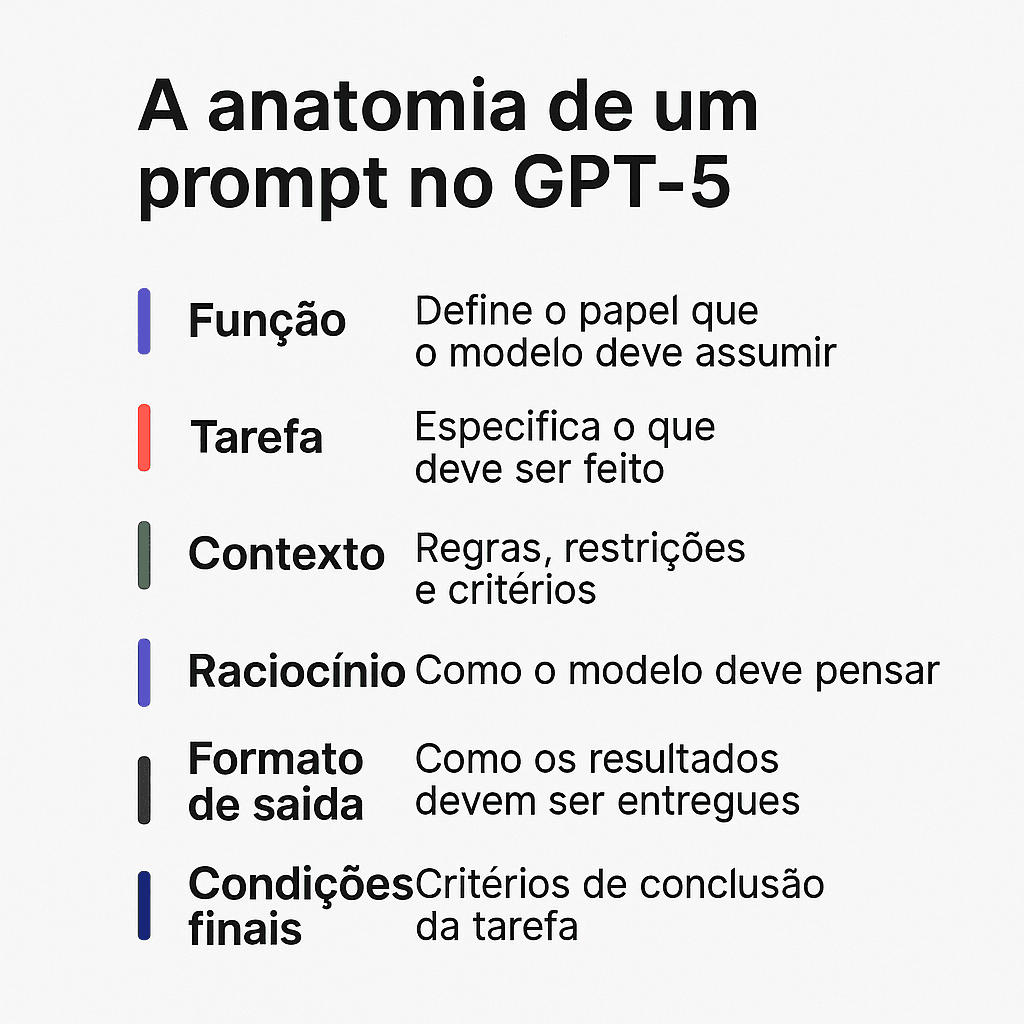Do You Really Know How to Write Effective Prompts for GPT-5?
The anatomy of a high-performance prompt for GPT-5 in 6 practical components — with ready-made templates, examples, and a checklist you can implement today.
Fradev / October 16, 2025

Visual breakdown of an effective prompt for GPT-5, highlighting role, task, context, reasoning, output format, and final conditions.
Do You Really Know How to Write Effective Prompts for GPT-5?
Most people still treat a prompt as just a command. It’s not. A good prompt is an operational contract between you and the model — it defines roles, boundaries, thinking patterns, and acceptance criteria. Below, I break down the anatomy of a high-performance prompt into 6 components, with a reusable template and a real example.
1) Role — state who the model is
Define the role precisely, not with fluff. The better the job description, the less ambiguity.
- Ex: “Act as a senior [[UX Writer]] specializing in B2B products in the SaaS sector.”
- When useful, add principles (e.g.: “clarity > style”, “avoid jargon”, “professional and direct tone”).
Goal: reduce degrees of freedom without stifling creativity.
2) Task — state what needs to be delivered
Be specific in the verb (create, rewrite, prioritize, compare, estimate). Bring in visible scope + restrictions.
- Ex: “List 3 options of medium-length hikes, within 2h of [[San Francisco]], excluding obvious tourist spots.”
Goal: turn a vague intention into executable work.
3) Context — rules, data, and quality criteria
Without context, the model guesses. With context, it optimizes.
- Domain rules, input data, persona, audience, objectives, and quality criteria (e.g.: geographic accuracy, terminology consistency).
- Include what not to do (e.g.: “do not mention [[Mount Tam]] or [[Golden Gate Park]]”).
Goal: reduce noise and align expectations.
4) Reasoning — how the model should think
Request steps, internal checks, and cross-referencing sources when applicable.
- Ex: “Check trail names with reliable sources and validate time/distance before responding.”
- If the task is critical, ask for self-checking (“review inconsistencies before finishing”).
Goal: make reasoning auditable and less prone to hallucinations.
5) Output format — predictable and ready-to-use
Define the output container (e.g.: [[Markdown]] table, JSON, hierarchical bullets) and mandatory columns/keys.
- Ex: Table with Name, Address, Time, Distance, Summary.
- For automation, prefer JSON with a fixed schema.
Goal: reduce rework and guarantee fit into your pipeline.
6) Final conditions — acceptance and verification criteria
Close the contract: what characterizes “done”? What are the success conditions?
- Ex: “The task is complete when there are 3 verified, unique, medium-length trails, within the time/distance, excluding popular locations.”
Goal: turn subjectivity into a Definition of Done.
Ready-to-use template (copy/paste)
Use this block as the basis for any task with GPT-5.
Adjust domain, restrictions, and format to your use case.
Act as <Role/Specialty> for <Audience/Sector>. Prioritize <Principles>.
Task:
- <Verb+deliverable> with <scope> and <main restrictions>.
- Include <quantity/variations> where applicable.
Context and Rules:
- <Input data / sources / exclusions / quality criteria>.
- <What to avoid>.
Reasoning:
- Follow steps: <1>, <2>, <3>...
- Check <consistencies / data / sources>.
- If gaps are found, suggest hypotheses and indicate uncertainty.
Output format:
- Deliver in <Markdown/JSON/Table>.
- Required fields: <...>.
Final conditions:
- Consider the task complete when <acceptance criteria>.



